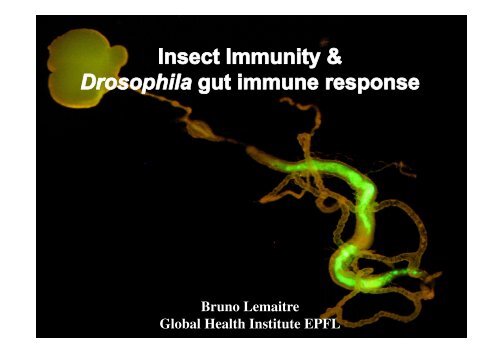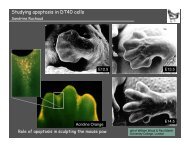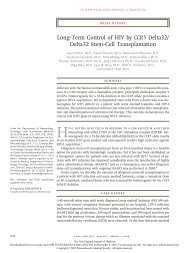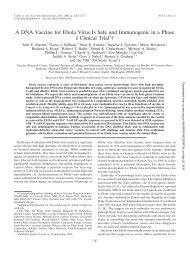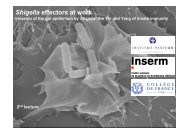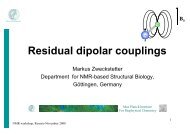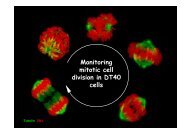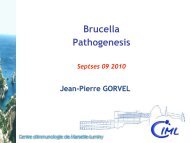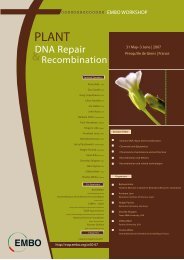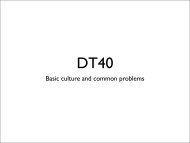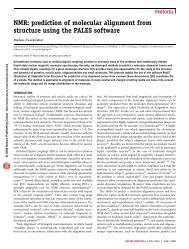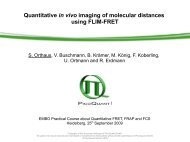Insect Immunity & Drosophila Gut Immune Response
Insect Immunity & Drosophila Gut Immune Response
Insect Immunity & Drosophila Gut Immune Response
Create successful ePaper yourself
Turn your PDF publications into a flip-book with our unique Google optimized e-Paper software.
Bruno Lemaitre<br />
Global Health Institute EPFL
<strong>Insect</strong> Characteristics & Peculiarities<br />
One of the most diverse animal group (> 70% of animal species)<br />
Include *many vectors of human diseases (mosquito, tse-tse flies…)<br />
*many damaging crop species<br />
* many beneficial microbes (bee, silkworm….)<br />
Many adaptive traits, thriving on varied ecological habitats and diets<br />
Animal feeding Parasitoid Plant feeding<br />
=>Strong capacity to deal with microbes
The enemies of insects<br />
• Viruses: Baculovirus<br />
• Bacteria: Bacillus thuringiensis<br />
• Fungi : Beauveria bassiana<br />
• Parasites : Plasmodium falciparum<br />
• Other insects: parasitoid wasps
Baculovirus infection of an insect host<br />
-circular, double stranded DNA<br />
- 80 -180 kbp<br />
- mostly restricted to invertebrates<br />
- used in biotechnology<br />
- biopesticide
Bacillus thuringiensis<br />
- Gram-positive, soil-bacterium,<br />
- express a pore forming toxin : the<br />
Cry toxin<br />
- used as Biopesticide<br />
- used in transgenic crop (Bt Maize)<br />
Crystal<br />
Spore
Beauveria Bassiana: an entomopathogenic fungus<br />
- produces lipase, chitinase<br />
and proteases<br />
- crosses through the cuticle<br />
of insects<br />
- used in field to protect<br />
crop from insects
Plasmodium development in Anopheles<br />
Derived from Riehle et al, 2003<br />
48 hours : Initiation of<br />
Oocysts development<br />
14 hours : ookinetes<br />
formation<br />
24 hours :<br />
Ookinetes penetration
Strategies to block malaria transmission<br />
- Mosquito Nets<br />
- Reduce standing water<br />
- <strong>Insect</strong>icide<br />
- Transgenic mosquitoes<br />
Shin et al, J. Exp. Biol., 2003
A wasp parasitizing of <strong>Drosophila</strong><br />
larvae<br />
Parasitoids wasps<br />
A wasp parasitizing a moth caterpillar
II - How insects (<strong>Drosophila</strong>)<br />
defend themselves<br />
• Antiviral defense<br />
• Physical and Chemical barriers<br />
– Reactive oxygen species<br />
• Cellular <strong>Immunity</strong><br />
– Phagocytosis<br />
– Capsule formation<br />
– Hemolymph coagulation and nodule formation<br />
• Humoral <strong>Immunity</strong><br />
– Melanization<br />
– Antimicrobial peptides
<strong>Drosophila</strong> antiviral defense<br />
1) RNA interference<br />
2) Endosymbiont-mediated immunity<br />
- Wolbachia are common intracellular bacteria of arthropods<br />
Purified particles of DCV<br />
- Wolbachia are transmitted vertically through host eggs, and manipulate host<br />
reproduction to increase transmission to the next generation.<br />
=> New studies suggest that Wolbachia infections in <strong>Drosophila</strong> can<br />
confer resistance to viruses and therefore act as mutualists
I - How insects defend themselves<br />
• Antiviral defense<br />
• Physical and Chemical barriers<br />
– Reactive oxygen species<br />
• Cellular <strong>Immunity</strong><br />
– Phagocytosis<br />
– Capsule formation<br />
– Hemolymph coagulation and nodule formation<br />
• Humoral <strong>Immunity</strong><br />
– Melanization<br />
– Antimicrobial peptides
Physical and chemical<br />
barriers<br />
Chitin-containing membranes<br />
- Cuticle<br />
- Peritrophic matrix<br />
In the gut:<br />
- Acidity<br />
- Digestive enzymes and lysozymes<br />
- Production of Reactive Oxygen<br />
Species (ROS) by DUOX<br />
PM:peritrophic matrix<br />
Mv: microvilli B: bacteria
I - How insects defend themselves<br />
• Antiviral defense<br />
• Physical and Chemical barriers<br />
– Reactive oxygen species<br />
• Cellular <strong>Immunity</strong><br />
– Phagocytosis<br />
– Capsule formation<br />
– Hemolymph coagulation and nodule formation<br />
• Humoral <strong>Immunity</strong><br />
– Melanization<br />
– Antimicrobial peptides
Cellular immunity<br />
Cell type<br />
plasmatocyte<br />
lamellocyte<br />
Bacterial infection<br />
Parasitoid Egg<br />
Function<br />
Phagocytosis<br />
Encapsulation
I - How insects defend themselves<br />
• Antiviral defense<br />
• Physical and Chemical barriers<br />
– Reactive oxygen species<br />
• Cellular <strong>Immunity</strong><br />
– Phagocytosis<br />
– Capsule formation<br />
– Hemolymph coagulation and nodule formation<br />
• Humoral <strong>Immunity</strong><br />
– Melanization<br />
– Antimicrobial peptides
Activation of melanization<br />
Melanization:<br />
activation of a<br />
proteolytic<br />
cascade
The <strong>Drosophila</strong> immune system: conclusions<br />
• <strong>Drosophila</strong> is now one of the best-characterized host defense systems<br />
among the metazoans.<br />
• <strong>Drosophila</strong> has multiple defense “modules” that can be deployed in a<br />
coordinated response against distinct pathogens => activation of the<br />
appropriate response<br />
• There are similarities between <strong>Drosophila</strong> host defense and essential<br />
facets of vertebrate innate immunity (signalling pathways)<br />
Future studies should investigate the links between <strong>Drosophila</strong><br />
immune defense and the ecology of this insect
The <strong>Gut</strong><br />
- Site of digestion<br />
- Major entry site of pathogens<br />
- Exposed to commensals<br />
(yeast, bacterial flora)<br />
Epithelial<br />
immunity<br />
Innate <strong>Immunity</strong><br />
Yersinia (Plague)<br />
Rickettsia (Typhus)<br />
Plasmodium (Malaria)<br />
Bacterial<br />
tolerance
- A Gram-negative, phytopathogenic bacteria<br />
- A natural <strong>Drosophila</strong> pathogen<br />
- Induces an Imd-dependent gut immune response upon oral<br />
infection<br />
Natural infection<br />
Filter paper<br />
+ sucrose <br />
+ bacteria<br />
Wild-type<br />
Wild-type<br />
Imd mutant<br />
Control<br />
Ecc15<br />
Ecc15<br />
Diptericin-lacZ
Wild-type<br />
E. coli<br />
DAP-PGN<br />
LYS- PGN<br />
PGRP<br />
-LC E12<br />
E. coli<br />
Diptericin-lacZ<br />
No role for the Toll pathway in the gut<br />
Imd<br />
Relish<br />
κB κB κB<br />
DAP PGN<br />
AMPs<br />
PGRP-LB<br />
PGRP-LC
PGRP-LB is en enzymatic PGRP regulated<br />
by the Imd pathway<br />
PGRP-LB<br />
<strong>Immune</strong><br />
non-reactive<br />
fragments<br />
Imd<br />
Relish<br />
κB κB κB<br />
DAP PGN<br />
AMPs<br />
PGRP-LB<br />
PGRP-LB
PGRP-LB<br />
Western Blot<br />
(gut extracts)<br />
wild-type<br />
C NI NI<br />
Relish E20<br />
Larval guts<br />
(fed with Ecc15)<br />
Wild-type PGRP-LB RNAi<br />
Dpt-LacZ Dpt-LacZ Dpt-GFP
Absence of infection Severe infection<br />
bacteria<br />
Imd<br />
pathway<br />
RELISH<br />
Imd<br />
Imd<br />
Imd<br />
pathway<br />
RELISH<br />
pathway pathway<br />
RELISH RELISH
The Imd pathway is activated throughout the gut,<br />
BUT<br />
Diptericin shows patterned expression<br />
Diptericin-lacZ<br />
?<br />
PGRP LC<br />
Imd pathway<br />
κB κB κB<br />
Control<br />
Caudal<br />
Diptericin<br />
Caudal RNAi<br />
Ryu et al (2008) Science 319<br />
⇒ additional regulatory elements<br />
restrict Diptericin expression<br />
in some gut cells.
PGRP-LC<br />
Wild-Type<br />
Imd<br />
Relish<br />
κB κB κB<br />
Caudal<br />
AMP Genes<br />
Ryu et al Science 2008<br />
PGRP-LC<br />
Caudal knock down<br />
Imd<br />
Relish<br />
κB κB κB<br />
AMP Genes
Tolerance to gut indigenous flora<br />
• Compartmentation: restriction of antimicrobial<br />
peptide production in the hindgut to protect the<br />
bacterial flora<br />
• Negative feed-back: Tight regulation of the Imd<br />
pathway to prevent its activation by indigenous<br />
bacteria
Both invasive and indigenous bacteria<br />
stimulate epithelium renewal<br />
Nicolas Buchon<br />
Nichole Broderick<br />
Buchon et al., Cell Host & Microbe 2009<br />
Buchon et al., Genes and Dev 2009
Major Remodeling of the <strong>Gut</strong> upon gut infection is<br />
required for barrier integrity
lumen<br />
Ohlstein et al. 2006, Nature<br />
Micchelli et al. 2006, Nature<br />
Stem cell<br />
Epithelial cells
Mitosis marker staining : phospho histone H3<br />
An#‐PH3 <br />
staining <br />
An/ PH3 <br />
DAPI <br />
Unchallenged Oral infec/on with Ecc15 <br />
UC <br />
An/ PH3 <br />
An# PH3 <br />
E1 E2 <br />
Number of PH3<br />
Positive cells / midgut<br />
UC Ecc15 inf <br />
lumen
Duox <br />
1 <br />
Imd <br />
H2O2 /O ‐<br />
2 <br />
AMPs <br />
1: Recogni/on of bacteria & immune response <br />
2: Bacteria destruc/on & damage to gut cells <br />
3: Cell repair & epithelium renewal <br />
What causes damage and epithelium renewal ? <br />
What are the pathways ? <br />
What is the relevance upon infec/on ? <br />
What happens with different types of bacteria ? <br />
?<br />
2 <br />
?<br />
?<br />
3 <br />
Buchon et al., 2009, Cell Host & Microbe
Epithelium stress & damage<br />
Bacterial direct stress “Collateral damage”<br />
Oxidative<br />
Stress ???
WT <br />
Unchallenged <br />
WT+Glutathione <br />
WT + Paraquat <br />
Proliferation : clones of lacZ positive cells Number of mitotic cells<br />
Ecc15 <br />
PH3 posi#ve cells <br />
WT WT dUOX‐ IR UAS‐IRC WT W<br />
UC Paraqua<br />
Ecc15
WT<br />
JAK-STAT<br />
deficient<br />
Unchallenged Ecc15 infection<br />
esg‐gal4; UAS‐GFP <br />
esg‐gal4, UAS‐GFP; uas‐Socs36E
upd3-Gal4 UAS-GFP
Intestinal<br />
muscles<br />
Intestinal<br />
epithelium<br />
<strong>Gut</strong> lumen<br />
Regula/on of ep/helium renewal upon Ecc15 infec/on <br />
Upd3<br />
DUOX <br />
Oxida/ve burst <br />
JAK/STAT ? <br />
Vein<br />
JAK/STAT EGFR/MAPK
Percentage of survival<br />
100<br />
80<br />
60<br />
40<br />
20<br />
0<br />
<strong>Immune</strong> response<br />
0 2 4 6 8 10<br />
Days post treatment<br />
Ecc15<br />
esg-gal4 uas Socs36E / DAPI<br />
WT<br />
UAS-dFADD Relish IR<br />
UAS-upd3 IR<br />
UAS UAS-STAT-IR Dome(dom<br />
neg)<br />
In enterocytes<br />
In ISCs<br />
Epithelium renewal
Pe-GFP<br />
Control P. entomophila
Control<br />
Ecc15<br />
P. entomophila<br />
Control<br />
P.entomophila<br />
Lack of gut integrity<br />
death<br />
DAPI
Two important host defense mechanisms:<br />
- ROS production by DUOX<br />
- Antimicrobial peptide production by the Imd pathway<br />
Negative feedback on the Imd pathway and compartimentation of Imd<br />
pathway activation are important for tolerance and the establishment of<br />
a beneficial flora<br />
A successful response to infection requires coordination of BOTH immune<br />
and homeostatic (repair) pathways<br />
Commensal bacteria stimulate epithelium renewal at a basal level<br />
Epithelium renewal as a target for gut pathogens
A Bacterial Effector Targets Mad2L2, an APC<br />
Inhibitor, to Modulate Host Cell Cycling<br />
Hiroki Iwai et al. 2007 Cell, Vol 130, 611-623, 2007<br />
Summary<br />
…Here, we show that the Shigella effector IpaB,<br />
when delivered into epithelial cells, causes cellcycle<br />
arrest by targeting Mad2L2, an anaphasepromoting<br />
complex/cyclosome (APC) inhibitor. ..<br />
These results strongly indicate that Shigella<br />
employ special tactics to influence epithelial<br />
renewal in order to promote bacterial<br />
colonization of intestinal epithelium<br />
microvilli<br />
Tight Jonction<br />
crypt<br />
α-defensin<br />
Paneth Cells<br />
Lymphocyte<br />
intra-épithélial<br />
Stem Cell<br />
Richard Locksley et al, <strong>Immunity</strong>.1er édition, p57.)
Collaborators<br />
GHI, EPFL, Lausanne (CH) <br />
Nicolas Buchon <br />
Nichole Broderick <br />
Takayuki Kuraishi <br />
Onya Opota <br />
David Welchman <br />
Claudine Neyen <br />
Sveta Chakrabar/ <br />
Mathilde Gendrin <br />
Jeremy Herren <br />
Olivier Binggeli <br />
Jean Philippe Boquete <br />
Allison Bardin (Ins/tut Pasteur, France) <br />
Dominique Mengin‐Lecreulx (Orsay, France) <br />
Sylvain Praverdan (CIG, Lausanne) <br />
CGM, Gif‐sur‐Yveae (F) <br />
Anna Zaidman‐Rémy <br />
Mickael Poidevin
- A successful response to infection requires coordination of BOTH<br />
immune and homeostatic pathways<br />
- Commensal bacteria stimulate epithelium renewal at a basal level<br />
- Epithelium renewal as a target for gut pathogens<br />
Buchon et al.; Genes and Dev 2009
Imd deficient flies have a higher<br />
bacterial load AND an altered flora<br />
composition<br />
PH3 posi/ve cells <br />
**<br />
***<br />
This higher bacterial load leads to<br />
increased epithelium renewal
<strong>Gut</strong>s of 30-day-old Relish E20 flies displayed altered gut<br />
morphology that are not observed in axenic conditions.<br />
Relish E20 ,30 days<br />
Conventionally raised Axenic
The EGFR pathway coordinates <strong>Drosophila</strong> stem cell<br />
proliferation and gut remodeling in response to infection
EC<br />
PM<br />
B<br />
Crop<br />
midgut<br />
cardia<br />
DAPI<br />
Pe rfp<br />
Hml-gal4, UAS-GFP<br />
Malpighian<br />
tubules<br />
rectum<br />
Humans <strong>Drosophila</strong><br />
Physical barriers Mucus Peritrophic matrix<br />
Chemicals, enzymatic barriers Low pH, proteases, lysozymes<br />
Flora<br />
Complex (>500 sp)<br />
Dense (10 12 /ml)<br />
<strong>Immune</strong> Defense AMPs, GALT, M cells<br />
Simple (30sp)<br />
Rare<br />
ROS, AMPs,<br />
<strong>Gut</strong>-associated Hemocytes
Esg‐GFP : <br />
Stem cells, <br />
enteroblasts <br />
newly <br />
generated <br />
enterocytes <br />
Micchelli et al.2006 <br />
Mosaic <br />
analysis <br />
lacZ+ clones <br />
Harrison and Perrimon 1993 <br />
Unchallenged Oral infec/on with Ecc15


